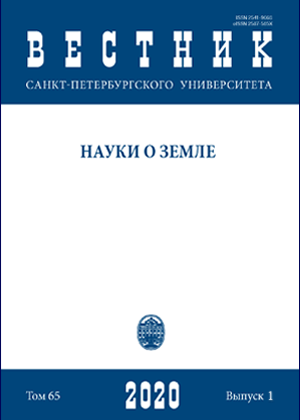Лампроитоиды Магнитогорской мегазоны (Южный Урал): петролого-геохимические особенности и геодинамическая обстановка формирования
DOI:
https://doi.org/10.21638/spbu07.2020.110Аннотация
Описаны вещественный состав и петрографические особенности дайковых лампроитоидов Магнитогорской мегазоны Южного Урала. Обоснован их более молодой (197–240 млн лет) возраст по сравнению с развитыми в этой же мегазоне лампрофирами (304–308 млн лет). Показано, что эти образования представляют собой единую петрографическую серию (от щелочно-ультраосновных до орендитов). Охарактеризованы минералогические особенности пород и сделан вывод об их близости по минералогическим критериям к лампроитам, но имеются и существенные отличия от последних. Изучены петрогеохимические особенности пород. По химизму они разделены на три группы: ультраосновные (встречаются редко), основные (абсолютное большинство проанализированных пород) и средние (орендиты). Рассчитаны средние составы выделенных групп, описаны особенности их нормативного состава и приведена геохимическая характеристика. Сделан вывод о сходстве изученных пород с постколлизионными магматическими образованиями. Реконструирован возможный механизм петрогенезиса лампроитоидов. Установлено, что наиболее вероятным мантийным источником для первичного расплава лампроитоидов является флогопитовый перидотит, подвергшийся частичному плавлению в присутствии существенно водного флюида с резко подчиненной ролью углекислоты в его составе. Кристаллизация расплава происходила по схеме, соответствующей экспериментально установленным фазовым взаимоотношениям в присутствии водного флюида. Уточнена геодинамическая позиция даек и проведено сравнение охарактеризованных пород с «классическими» лампроитами различных регионов. Показано их сходство с лампроитами Алдана и Испании, формирование которых связано с древними зонами субдукции. С учетом геологической обстановки проявления лампроитоидов предложено выделить их в «постколлизионный» подтип. Проведенные исследования позволяют подтвердить сделанный ранее вывод о том, что лампроитоиды Магнитогорской мегазоны не являются первичными источниками уральских алмазов.
Ключевые слова:
лампроитоиды, Южный Урал, петрогенезис, геодинамическая обстановка
Скачивания
Загрузки
Опубликован
Как цитировать
Выпуск
Раздел
Лицензия
Статьи журнала «Вестник Санкт-Петербургского университета. Науки о Земле» находятся в открытом доступе и распространяются в соответствии с условиями Лицензионного Договора с Санкт-Петербургским государственным университетом, который бесплатно предоставляет авторам неограниченное распространение и самостоятельное архивирование.






